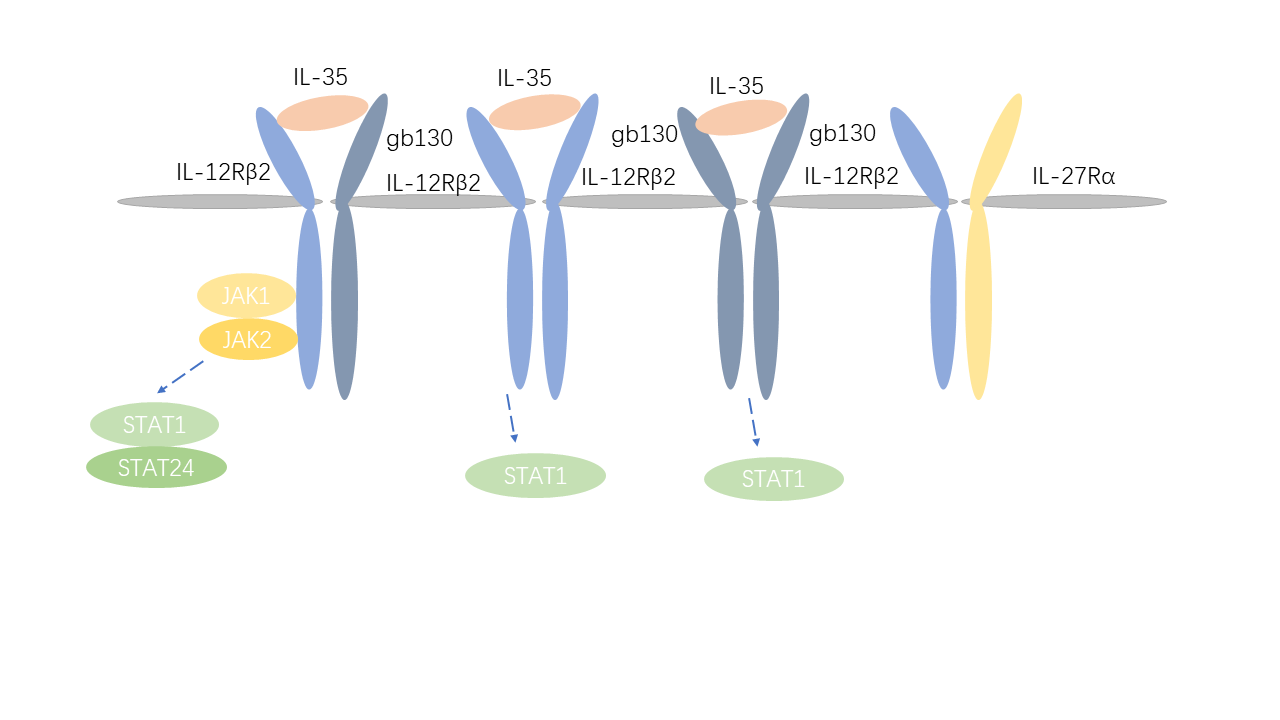Introduction
IL-35 is a member of IL-12 cytokine family and is a heterodimer composed of Epstein-Barr birus induced gene 3 and p35 subunit. IL-35 can be expressed by monocytes, T cells, B cells, Treg cells and tumor cells. It can directly inhibit the tumor immune status of the tumor microenvironment and cause immune escape. It can also directly act on certain types of tumor cells to promote tumor progression. What’more,it also plays a role in cardiovascular disease, asthma, and autoimmune diseases.
Mechanism and Function
There are four receptors for IL-35, namely IL-12Rβ2: gb130, IL-12Rβ2: IL-12Rβ2, gb130: gb130 and IL-12Rβ2: IL-27Rα. Among them, IL-12Rβ2 is mainly expressed by activated T cells and NK cells, and almost all cells can express gb130. IL-35 binds to IL-12Rβ2: gb130 receptor and first activates the Janus family (Jaks) for signal transduction and activates STAT1 and STAT4 in signal transducers and activators of transcription (STAT). IL-35 can also interact with IL-12Rβ2:IL-12Rβ2 or gb130:gb130 to activate STAT1. IL-12Rβ2 mainly activates JAK1 and JAK2, and phosphorylates downstream STAT4 and STAT1 molecules, respectively. The signal transduction of IL-35 is achieved through the JAK-STAT family.
There is a relationship between IL-35 and many diseases. IL-35 is related to autoimmune diseases. It can promote the proliferation of Treg cells while inhibiting Th17 cells to regulate. It also regulates asthma by regulating these two cell groups. It can also inhibit the differentiation of Th17 cells to inhibit the expression of pro-inflammatory factors in cardiomyocytes to protect the myocardium. There is a connection between IL-35 and viral infection. IL-35 can inhibit the function of CD4+ and CD8+ T cells in peripheral blood. IL-35 is also inextricably linked to tumors. IL-35 can be expressed in many tumor cells, such as B-cell lymphoma, nasopharyngeal carcinoma and melanoma. Tumor-derived IL-35 can promote the accumulation of CD11b+Gr1+ myeloid cells, thereby promoting tumor angiogenesis. In addition, IL-35 can promote Treg expansion, while inhibiting the proliferation of CD4+CD25+ effector T cells to cause tumor immune escape. IL-35 can also up-regulate the expression of cyclin, Bcyclin D and cdf4, while down-regulating the expression of p27 to promote tumor cell proliferation. In fact, It can also up-regulate the expression of Bcl-2 and down-regulate the expression of TRAILR1 to inhibit tumor cell apoptosis. IL-35 can also perform immune regulation. It can induce Th1 cells to be at the end of G1 and inhibit their proliferation. It can also induce the production of IL-35-producing regulating T cell (iTr35). iTr35 forms positive feedback by secreting IL-35 to exert its effect. Immunosuppressive effect.
 Fig 1. Mechanism of Signaling
Fig 1. Mechanism of Signaling
Creative Proteomics can provide cytokine detection platform for scientific research. According to different purposes, our dedicated analysts will customize exclusive solutions for you. We aim to provide customers with high-quality and convenient services to help you accelerate the progress of your project.
Our cytokine detection service includes but is not limited to:
- Quantitative and qualitative detection of cytokines in different species
- Quantitative and qualitative detection of cytokine antibodies
- Quantitative and qualitative detection of single/multiple cytokines
Sample requirements
- Sample Types-Blood, serum, plasma, cerebrospinal fluid, cell culture supernatant, tissue homogenate, cell culture medium, urine, tumor, etc.
- Sample Volume-It is optimal for at least 200µl of each sample. This volume allows for triplicate testing of each sample.
Our advantages:
- Efficient design: Multiplex reaction detecting in various methods are available, which can be selected according to different samples and requirements.
- Sensitive Detection: High-quality antibodies are used in the detection process to improve detection specificity and accuracy.
- Reliable results: The feedback results are professional and efficient
Technology platform:
We mainly provide the Luminex cytokine detection platform. Luminex uses fluorescently encoded microspheres with specific antibodies to different target molecules. The different microspheres can be combined freely to a certain extent so that up to 100 analytes can be tested multiple times simultaneously in a single experiment.
The Luminex cytokine assay platform has the following advantages:
- Multiple detection: simultaneous detection of 100 biological targets
- Short experiment time: 1-3 weeks
- High sensitivity: the lower limit of accurate quantification is as low as 0.1 pg/mL
- Save samples: only need a sample volume as low as 25 μL
- Time saving: the experiment process only takes 4 hours
For your different needs, we can also provide the following detection methods:
- Enzyme-linked immunosorbent assay (ELISA)
- Flow cytometry
Workflow

For more information about the IL-35 detection service or need other detection requirements, please contact us.
References:
- Collison L W, Workman C J, Kuo T T, et al. The inhibitory cytokine IL-35 contributes to regulatory T-cell function. Nature, 2007, 450(7169):566-569.
- Niedbala W, Wei X Q, Cai B, et al. IL-35 is a novel cytokine with therapeutic effects against collagen-induced arthritis through the expansion of regulatory T cells and suppression of Th17 cells. European Journal of Immunology, 2007, 37(11):3021-3029.

